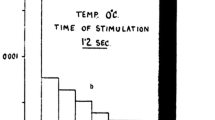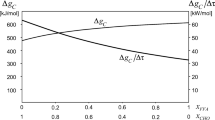Summary
-
1.
The physiological characteristics of the chick anterior latissimus dorsi muscle were measured and compared with those of the adjacent posterior latissimus dorsi muscle. The rate of shortening of the anterior latissimus dorsi was about 15 times slower than that of the posterior muscle.
-
2.
The anterior latissimus dorsi was found to be able to sustain isometric tension for long periods of time. In spite of this the resting ATP level of this muscle was only 1 μmole/g whereas in the posterior muscle it was about 3 μmoles/g.
-
3.
The amount of ATP used by the anterior latissimus dorsi in performing isotonic work and in maintaining isometric tension was measured. This involved incubating the muscles for 40 min in a 0.38 mM solution of 2,4 dinitrofluorobenzene (DNFB) solution in Ringer at 2° C. The muscles were rapidly frozen during contraction by immersion in a mixture of Freons 12 and 13 cooled to −160° C.
-
4.
The anterior latissimus dorsi was found to be relatively inefficient at performing isotonic work (Efficiency=100 g cm/μmole of ATP per g) but very efficient in maintaining isometric tension. Very little ATP was used in maintaining isometric tension for periods as long as a minute.
-
5.
The results were compared with those for hamster muscles presented in a following paper.
Similar content being viewed by others
References
Bach-y-Rita, P., Ito, F.: In vivo studies on fast and slow muscle fibres in cat extraocular muscle. J. gen. Physiol. 49, 1177–1198 (1966).
Bárány, M.: ATPase activity of myosin correlated with speed of muscle shortening. J. gen. Physiol. 30, 197–218 (1967).
Bendall, J. R.: In Muscles, molecules and movement, chap. 4. London: Heinemann 1969.
Buller, A. J., Eccles, J. C., Eccles, R. M.: Differentiation of fast and slow muscles in the cat hind limb. J. Physiol. (Lond.) 150, 399–416 (1960a).
—: Interactions between motoneurons and muscles in respect of the characteristic speeds of their responses. J. Physiol (Lond.) 150, 417–438 (1960b).
Cain, D. F., Davies, R. E.: Breakdown of adenosine triphosphate during a single contraction of working muscle. Biochem. biophys. Res. Commun. 8, 361–366 (1962).
—: Rapid arrest of metabolism with melting freon. (First Internat. Colloquium.) In: Rapid mixing and sampling techniques in biochemistry, p. 229–237 (ed. B. Chance, R. H. Eisenhardt, Q. H. Gibson and K. K. Lonberg-Holm). New York: Academic Press 1964.
—, Infante, A. A., Davies, R. E.: Chemistry of muscle contraction. Adenosine triphosphate and phosphorylcreatine as energy supplies for single contractions of working muscle. Nature (Lond.) 196, 214–217 (1962).
Close R.: Dynamic, properties of fast and slow skeletal muscles of the rat during development. J. Physiol. (Lond.) 173, 74–95 (1964).
Davson, H.: A textbook of general physiology, 1st edit., p. 481–484. London: Churchill Ltd. 1951.
Ginsborg, B. L.: Spontaneous activity in muscle fibres of the chick. J. Physiol. (Lond.) 150, 707–717 (1960a).
—: Some properties of avian skeletal muscle fibres with multiple neuromuscular junctions. J. Physiol. (Lond.) 154, 581–598 (1960b).
Goldspink, G., Larson, R. E., Davies, R. E.: The immediate energy supply and the cost of maintenance of isometric tension for different muscles in the hamster. Z. vergl. Physiol. 66, 389–397 (1970).
Hess, A.: The structure of slow and fast extrafusal muscle fibres in the extraocular muscles and their nerve endings in the guinea pig. J. cell. comp. Physiol. 58, 63–80 (1961).
—, Pilar, G.: Slow fibres in the extraocular muscles of the cat. J. Physiol. (Lond.) 169, 780–798 (1963).
Hoekman, T., Abbott, B. C., Matsumoto, Y.: Heat production of contracting phasic and tonic chicken muscles. Biophys. Soc. Abstr. 11th Ann. Mtg. A 119 (1968).
Somlyo, A. P., Somlyo, A. V.: Pharmacology of excitation-contraction coupling in vascular smooth muscle and in avian slow muscle. Fed. Proc. (in press) (1969).
Author information
Authors and Affiliations
Additional information
On leave from the University of Hull, England.
Whilst this work was being carried out two of the authors (R.E.D. and G.G.) were in receipt of research grants from the Muscular Dystrophy Associations of America. Professor R. E. Davies was also in receipt of U.S.P.H.S. research grants HE 02520-12 and GM 00694-7. Dr. G. Goldspink also-wishes to acknowledge the receipt of a Welcome Trust Travel Grant for travel to the U.S.A. in order to carry out this work. The authors are also grateful for the valuable technical assistance rendered by Mr. S. E. Waterson and Miss Margaretta Svensson.
Rights and permissions
About this article
Cite this article
Goldspink, G., Larson, R.E. & Davies, R.E. Thermodynamic efficiency and physiological characteristics of the chick anterior latissimus dorsi muscle. Z. Vergl. Physiol. 66, 379–388 (1970). https://doi.org/10.1007/BF00299937
Received:
Issue Date:
DOI: https://doi.org/10.1007/BF00299937




